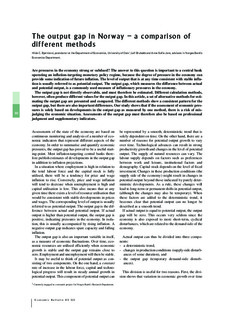The Output Gap in Norway - a Comparison of Different Methods
Abstract
Are pressures in the economy strong or subdued? The answer to this question is important to a central bank operating an inflation-targeting monetary policy regime, because the degree of pressure in the economy can provide some indication of future inflation. The level of output that is at any time consistent with stable inflation is usually referred to as potential output. The output gap, which measures the difference between actual and potential output, is a commonly used measure of inflationary pressures in the economy. The output gap is not directly observable, and must therefore be estimated. Different calculation methods, however, often produce different values for the output gap. In this article, a set of alternative methods for estimating the output gap are presented and compared. The different methods show a consistent pattern for the output gap, but there are also important differences. Our study shows that if the assessment of economic pressures is solely based on developments in the output gap as measured by one method, there is a risk of misjudging the economic situation. Assessments of the output gap must therefore also be based on professional judgment and supplementary indicators.

